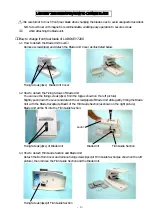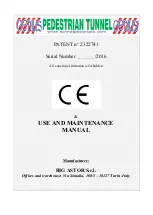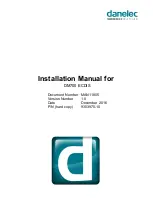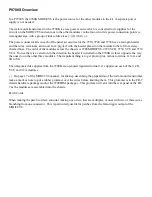
6
1. While still in PLAY mode, select preset 1 using the UP/DOIT or DOWN switch while the cursor is under the preset
number.
2. Press the MODE switch once to enter the Programming Group Selection Menu. Notice the cursor is already under PRST,
ready to enter the preset programming menus. Press the MODE switch again to move to the Preset Naming Menu.
NAME THE PRESET:
1. To clear out the name that may already be displayed for this preset, press the DOWN and UP/DOIT switch together. All
characters will be cleared out. Use the SELECT switch and the DOWN and UP/DOIT switch to name this preset
"DISTORTION".
PROGRAM THE PATCH AND GAIN:
1. Press the MODE switch to move to the Patching and Gain Menu to connect the patches and adjust the gain levels.
2. If you wish to clear out the entire matrix to start with a "clean" slate, press the DOWN and UP/DOIT switch together. All
input to output connections will be removed and all gains will be changed to "OFF". If programming for the first time, the
matrix will already be clear. NOTE: WHEN “OFF” IS DISPLAYED, THIS MEANS THE CONNECTION SHOWN IS
NON-EXISTENT. IT DOES NOT MEAN THAT THE CONNECTION IS THERE BUT SIMPLY MUTED AS YOU
MIGHT BE INCLINED TO THINK
3. The cursor should be located in the upper left of the display. This is the "SOURCE" area and lists all of the signals
presently connected to the IN jacks of the Switchblade. Press the DOWN or UP/DOIT switch until the name of your
instrument is showing (i.e. "GUITAR" or "KEYBOARD" etc.). These are the names that you created while in the Setup
Menus.
4. Press the SELECT switch so the cursor moves to the upper right side of the display. This is the "DESTINATION" area.
Press the DOWN or UP/DOIT switch until the name of your distortion appears (i.e. DISTORT"). This source- destination
combination represents a particular patch you wish to connect and apply gain to.
5. Press the SELECT switch so the cursor moves to the lower left side of the display. This is the "GAIN" area (or "START
GAIN" area if doing continuous control). Press the DOWN or UP/DOIT switch to change the gain to "0 dB" of the display.
This is the gain from the instrument to the input of the distortion effect.
6. Press the SELECT switch again, notice that a second gain number appears on the lower right side.
This gain normally
tracks the value set in the first gain and can be ignored if you are not setting any continuous control gains.
For now just
press the SELECT switch one more time to get back to the "SOURCE" area.
7. Now you need to connect the output of the distortion to the amplifier and set its gain as well. To do this, repeat steps 6-8
again, but select "DISTORT" as the source and "AMP" as the destination. Set the gain to 0dB again. The connections you
have just made can be summarized in a chart as shown here:
SOURCE
DESTINATION
GAIN
instrument distortion
0dB
distortion amplifier
0dB
You can now play your instrument while still in this menu to hear the result of the patch.
REVIEWING THE PATCHES.
You can review the patches you just created very easily by
pressing and holding
the
SELECT switch while in the patch menu. The display will show the word
REVIEW
. You can now use the UP DOWN
switch to scroll through the connections you have made (in this case, 2 connections).
This menu is invaluable for double
checking your patches after programming or for checking patches in an unknown preset.
To get back to the patch menu
simply press the SELECT switch once. Notice that you will return to the same place in the PATCH menu as you were at in
the REVIEW menu allowing fast editing if you need to make changes while reviewing. THE MODE SWITCH WILL NOT
OPERATE WHILE IN THE REVIEW MENU. Pressing the SELECT switch is the only way to exit the REVIEW menu.








































